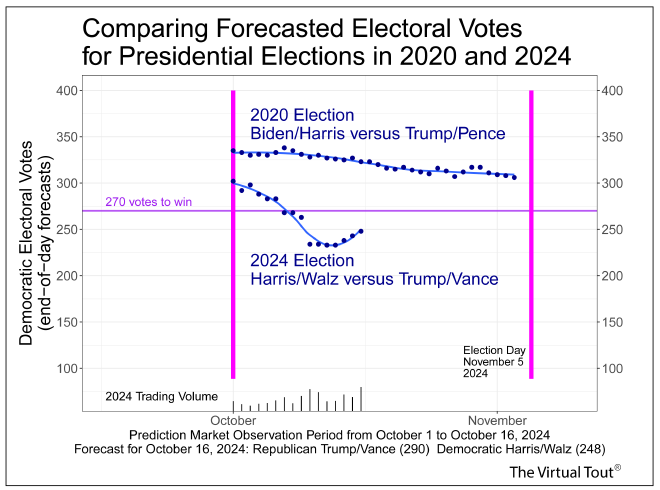October 16, 2024
How does 2024 compare with 2020? #
With nineteen days to go before the election, the story of 2024 could be heading toward a sad ending for Democrats. Can the Harris/Walz ticket turn things around?
The 2024 election season has been unusual in many ways. It started as a rematch between Trump and Biden at the top of the major party tickets. An initial debate shock then forced Biden to withdraw from the race, and he endorsed his vice president, Kamala Harris, to lead the Democratic ticket.
There was no Democratic primary following Biden’s withdrawal. Harris secured the Democratic nomination with ease and her selection of Walz as her running mate was well received. There were no floor fights at the Democratic National Convention. Democrats have espoused themes of unity and openness, even to the point of welcoming Republicans into their fold.
With a shortened election cycle, we have seen great volatility in polls and prediction markets. For the first time in US history, the race for the presidency has gone from toss-up to Republican landslide, to toss-up, to a possible Democratic landslide, to toss-up, and now leans Republican.
As we head into the last days before November 5, we expect additional volatility. Democratic loyalists are concerned about recent polls and prediction markets. And rightly so.
How does the 2024 race for the White House compare with 2020?
For the 2020 presidential election, The Virtual Tout® used a bottom-up forecasting approach, updating electoral vote forecasts every hour and posting those forecasts to Twitter. We learned about a slight Republican bias in those forecasts, which we correct for in current models.
For the 2024 presidential election, we have been using a top-down forecasting approach, as described under Top-Down Forecasting, Focus on Electoral Votes, Estimating Vote Shares, and Electoral Vote Step Functions.
Despite differences in methods between 2020 and 2024, we have been consistent in using PredictIt as a trusted data source. As we explain in Prediction Markets, we rely on seven criteria for selecting a prediction market source, and PredictIt satisfies those criteria more fully than other prediction markets.
Drawing on prediction market prices, as well as sixty years of presidential election history, we have generated bias-corrected electoral vote forecasts for the presidential elections of 2020 and 2024. We compare those forecasts across the last days of the campaigns, as shown in the figure below:

For the 2020 presidential election, forecasted Democratic electoral votes were highest on October 7, 2020, following the first presidential debate between Trump and Biden in late September and Donald Trump’s Covid-19 announcement and hospitalization. Forecasted electoral votes were lowest on the morning of the election, November 3, 2020. The Biden/Harris ticket won the 2020 presidential election with 306 Electoral College votes.
Forecasted Electoral College votes in 2020 varied across the final days of the race for the White House, but not nearly so much as 2024 forecasted electoral votes have varied.
For Democratic loyalists, it should be disconcerting to see that at no time during October and early November of 2020 did the Democratic ticket of Biden and Harris fall below the 270 line for winning in the Electoral College. Since October 7, 2024, Democratic ticket of Harris and Walz has indeed fallen below the 270 line.
Many citizens have already cast their votes in 2024. What do those votes show? And what can we expect from votes cast between now and election day?
As we approach November 5, The Virtual Tout® will do what have been doing throughout this election season: Following the data and leading with science.
See the log of Blog postings.
The most recent news is on the home page.